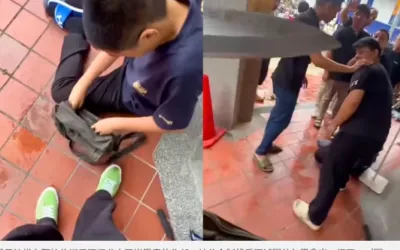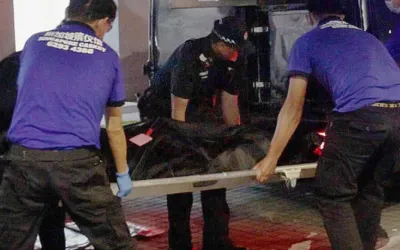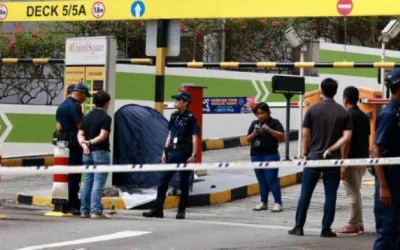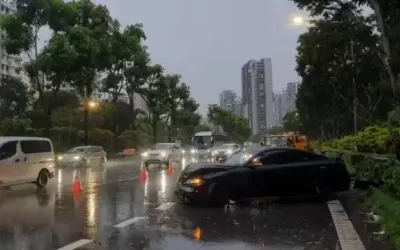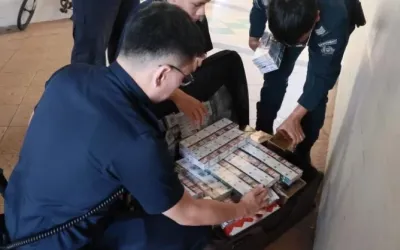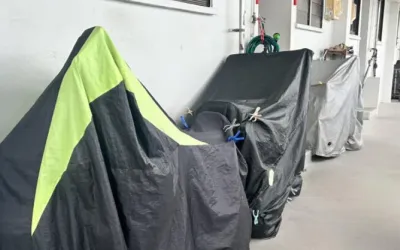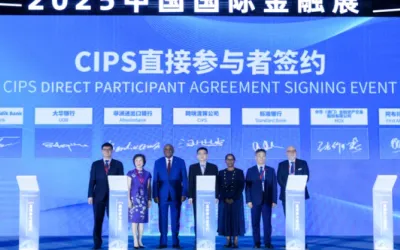Besides the initial patrol vessel, 11 more vessels from MPA and their contractors were deployed to perform different roles during the initial phase of the response on 14 June.
MPA also checked the damaged vessel to ensure that it would not sink, the crew were safe and there was no further spillage of oil.
MPA then activated T&T Salvage Asia to lay heavy-duty containment booms around the damaged vessel. T&T’s vessel arrived at the incident location at 9.41 pm on 14 June, as it took a few hours to load the vessel with the heavy equipment and another few hours to sail to the incident site.
Despite the challenges of working at night and under bad weather conditions, T&T did well to deploy 200 metres of oil booms around the damaged vessel by working through the night. The deployment of the oil booms was completed at 5.15 am on 15 June.
Some have asked why MPA did not immediately deploy the containment booms onboard its patrol vessel while waiting for T&T’s vessel to arrive. Sir, the booms onboard the MPA patrol vessel are lightweight oil containment booms which are suitable for dealing quickly with small-scale and localised oil spills, such as oil leakages during bunkering operations. These lightweight booms were assessed to be unsuitable for dealing with the oil spill incident on 14 June, which was a more serious spill involving the sudden discharge of an estimated 400 tonnes of oil into the sea.
For such spills, the patrol vessel will focus on spraying dispersants and deploy contractors to lay heavy-duty oil containment booms around the damaged vessel as a preventive measure in case there is further spillage of oil from the vessel.
Sir, this is the established procedure, which is in line with international practices for dealing with oil spills, and the MPA response team on the patrol vessel followed the procedure correctly.
I had explained during last week’s joint press conference that the main purpose of the containment booms around the damaged vessel was not to “fence in” all the spilled oil. When there is a sudden discharge of a large amount of oil, like what happened on 14 June, the spilled oil will not remain stationary at the incident site. It will be carried by tidal currents and waves to other locations. The containment booms were therefore intended as a preventive measure in case there was further oil spillage from the damaged vessel.
The containment boomd can also help to catch some of the oil spill which remained in the vicinity of the incident location and did not float elsewhere. But this is not 100% foolproof, because the tidal currents and waves can carry the oil to go below or above the booms.
In addition to laying containment booms around the damaged vessel, we also deployed oil skimmers. Based on guidance from industry experts such as the ITOPF, oil skimmers are most effective against large and thick patches of oil.
Hence, before deploying the skimmers, MPA and its contractors had to first confirm the location of the large oil patches. This task was challenging for a number of reasons.
First, due to thundery showers on 14 June afternoon, visibility was poor and the vessels from MPA and their contractors were not able to spot large patches of oil in the sea in the first few hours after the incident.
Second, as the density of the spilled oil in this case is very close to that of seawater, the oil slicks might have gone below the water surface, making detection harder.
When night fell, the reduced visibility made it even more difficult for MPA and its contractors to locate the spilled oil.
Throughout its response, MPA used a multi-pronged approach involving drones, satellite imagery and sightings from ships at sea and personnel on the ground to confirm the location of large oil patches.
In the morning of 15 June, when large oil patches were located, MPA deployed oil skimmers to skim the oil from the sea.
MPA and its contractors also carried out the targeted deployment of booms along our coastlines and waterfronts to facilitate clean-up operations. This approach ensures the booms are placed where they can be most effective. In response to Mr Louis Chua’s question, MPA did not prioritise oil collection in certain areas before deploying booms to contain the spill.
Preventive measures were also implemented at biodiversity sensitive areas such as the Chek Jawa Wetlands at Pulau Ubin, given the potential environmental impact.
We have deployed a total of around 4,000 metres of oil containment booms. To Mr Christopher de Souza’s question, our contractors also used absorbent booms with hydrophobic content.
Our clean-up methods and operations are guided by international experts from ITOPF, and our agencies work closely with specialised companies and contractors who have strong track records in responding to oil spills. We work with them on the deployment of assets to ensure optimal outcomes, taking into account factors such as the geography of the area, weather conditions, prevailing winds and tidal conditions.
Sir, some Members have asked about the timeliness of our communications to the public. Our agencies had provided regular updates from the day of the incident on 14 June. Our approach is to push out relevant information to the public as soon as possible, such as information on air and water quality, while we continue with the operations at sea and on land to deal with an evolving situation. Minister Grace Fu, Minister Desmond Lee and I also provided updates on the management and impact of the oil spill in the days following the incident. Please allow me to elaborate on the communications timeline.
On the afternoon of 14 June, MPA informed the other agencies of the oil spillage. After being alerted, the agencies mobilised their staff to actively monitor the situation and stood ready to respond.
At 6.03 pm that day, MPA notified the public of the allision and oil spill through a media release while it continued to assess and respond to the developing situation.
At around 9.20 pm, the Sentosa Development Corporation (SDC) began to cordon off affected parts of Palawan beach, when they first sighted oil on the beach. Early next morning on 15 June at about 7.00 am, SDC observed the further spread of oil in waters at Palawan, Siloso and Tanjong beaches, cordoned off affected areas and deployed workers to commence clean-up. At 10.59 am, SDC published a post on their Facebook page and website to inform the public that the waters of Tanjong, Palawan and Siloso Beach on Sentosa were closed for clean-up operations, but the three beaches remained open.

